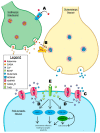Ketamine and the Disinhibition Hypothesis: Neurotrophic Factor-Mediated Treatment of Depression
- PMID: 37242525
- PMCID: PMC10221455
- DOI: 10.3390/ph16050742
Ketamine and the Disinhibition Hypothesis: Neurotrophic Factor-Mediated Treatment of Depression
Abstract
Ketamine is a promising alternative to traditional pharmacotherapies for major depressive disorder, treatment-resistant depression, and other psychiatric conditions that heavily contribute to the global disease burden. In contrast to the current standard of care medications for these disorders, ketamine offers rapid onset, enduring clinical efficacy, and unique therapeutic potential for use in acute, psychiatric emergencies. This narrative presents an alternative framework for understanding depression, as mounting evidence supports a neuronal atrophy and synaptic disconnection theory, rather than the prevailing monoamine depletion hypothesis. In this context, we describe ketamine, its enantiomers, and various metabolites in a range of mechanistic actions through multiple converging pathways, including N-methyl-D-aspartate receptor (NMDAR) inhibition and the enhancement of glutamatergic signaling. We describe the disinhibition hypothesis, which posits that ketamine's pharmacological action ultimately results in excitatory cortical disinhibition, causing the release of neurotrophic factors, the most important of which is brain-derived neurotrophic factor (BDNF). BDNF-mediated signaling along with vascular endothelial growth factor (VEGF) and insulin-like growth factor 1 (IGF-1) subsequently give rise to the repair of neuro-structural abnormalities in patients with depressive disorders. Ketamine's efficacious amelioration of treatment-resistant depression is revolutionizing psychiatric treatment and opening up fresh vistas for understanding the underlying causes of mental illness.
Keywords: arketamine; brain-derived growth factor; esketamine; ketamine; major depressive disorder; synaptogenesis; treatment-resistant depression.
Conflict of interest statement
The authors declare that they have no conflict of interest.
Figures


Similar articles
-
Mechanisms of ketamine action as an antidepressant.Mol Psychiatry. 2018 Apr;23(4):801-811. doi: 10.1038/mp.2017.255. Epub 2018 Mar 13. Mol Psychiatry. 2018. PMID: 29532791 Free PMC article. Review.
-
Uncovering the Underlying Mechanisms of Ketamine as a Novel Antidepressant.Front Pharmacol. 2022 Jul 7;12:740996. doi: 10.3389/fphar.2021.740996. eCollection 2021. Front Pharmacol. 2022. PMID: 35872836 Free PMC article. Review.
-
Role of neurotrophic and growth factors in the rapid and sustained antidepressant actions of ketamine.Neuropharmacology. 2023 Feb 15;224:109335. doi: 10.1016/j.neuropharm.2022.109335. Epub 2022 Nov 17. Neuropharmacology. 2023. PMID: 36403852 Review.
-
Arketamine, a new rapid-acting antidepressant: A historical review and future directions.Neuropharmacology. 2022 Nov 1;218:109219. doi: 10.1016/j.neuropharm.2022.109219. Epub 2022 Aug 14. Neuropharmacology. 2022. PMID: 35977629 Review.
-
AMPA Receptor Activation-Independent Antidepressant Actions of Ketamine Metabolite (S)-Norketamine.Biol Psychiatry. 2018 Oct 15;84(8):591-600. doi: 10.1016/j.biopsych.2018.05.007. Epub 2018 May 14. Biol Psychiatry. 2018. PMID: 29945718
Cited by
-
Ketamine's Amelioration of Fear Extinction in Adolescent Male Mice Is Associated with the Activation of the Hippocampal Akt-mTOR-GluA1 Pathway.Pharmaceuticals (Basel). 2024 May 22;17(6):669. doi: 10.3390/ph17060669. Pharmaceuticals (Basel). 2024. PMID: 38931336 Free PMC article.
-
Research Progress on the Mechanism of Ketamine in Neuropathic Pain Comorbid Depression.Neuropsychiatr Dis Treat. 2025 Aug 9;21:1623-1636. doi: 10.2147/NDT.S534938. eCollection 2025. Neuropsychiatr Dis Treat. 2025. PMID: 40822041 Free PMC article. Review.
-
Brain region-specific roles of brain-derived neurotrophic factor in social stress-induced depressive-like behavior.Neural Regen Res. 2025 Jan 1;20(1):159-173. doi: 10.4103/NRR.NRR-D-23-01419. Epub 2024 Apr 3. Neural Regen Res. 2025. PMID: 38767484 Free PMC article.
-
Activation of σ1-Receptors by R-Ketamine May Enhance the Antidepressant Effect of S-Ketamine.Biomedicines. 2023 Sep 28;11(10):2664. doi: 10.3390/biomedicines11102664. Biomedicines. 2023. PMID: 37893038 Free PMC article.
-
Depression, an unmet health need in Africa: Understanding the promise of ketamine.Heliyon. 2024 Mar 28;10(7):e28610. doi: 10.1016/j.heliyon.2024.e28610. eCollection 2024 Apr 15. Heliyon. 2024. PMID: 38601594 Free PMC article. Review.
References
-
- World Health Organization Depression. [(accessed on 6 March 2023)]. Available online: https://www.who.int/news-room/fact-sheets/detail/depression.
-
- National Institute of Mental Health Major Depression. [(accessed on 5 March 2023)]; Available online: https://www.nimh.nih.gov/health/statistics/major-depression.
-
- American Psychiatric Association . Diagnostic and Statistical Manual of Mental Disorders. American Psychiatric Association Publishing; Washington DC, USA: 2022.
-
- Angst J., Angst F., Stassen H.H. Suicide Risk in Patients with Major Depressive Disorder. J. Clin. Psychiatry. 1999;60((Suppl. S2)):57–62; discussion 75–76, 113–116. - PubMed
Publication types
LinkOut - more resources
Full Text Sources
Miscellaneous

